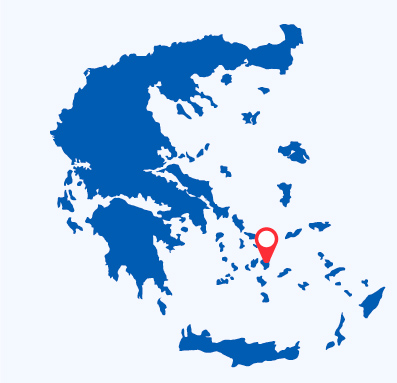Naxos is located in the archipelago of the Cyclades Islands and is the largest of all. Together with Paros, Santorini and Mykonos Islands, it is one of the four corners called the "magic golden rectangle" and given their proximity they can be an excellent starting point for a traveling holiday in Greece by touching them all.
Naxos offers its visitors 150 kilometers of coastline with immense beaches of soft sand and shallow waters with clean waters and bright colours, so much so that families with children, couples and those who want lush nature to explore every year choose it as half.
It covers an area of 430 square kilometers so not very small with lots of things to see and do. To the west, where the capital is located, it is mainly flat with vast plains and numerous sandy beaches, while in the center it has gentle hills and mountains that reach up to 1000 metres, waterways which, as in the past, fuel the production of fruit, vegetables, wine and yellow gold the oil which, in addition to satisfying the needs of the inhabitants, is also exported to supply the nearby islands. Here is Mount Zas, the highest peak of Naxos. To the north and north-east the coast becomes more rocky and wild.
According to mythological stories, Zeus grew up in Naxos (his birth instead took place in Crete). Having fallen in love with Semeli, daughter of King Kadmo of Thebes, he fathers a son Dionysus, God of wine and joy. The mother dies while she is carrying the baby so Zeus places it inside her thigh to give it life. Dionisos grew up in Naxos and loved it so much that he made it fertile and rich in vineyards which still offer sublime nectar today. Another myth, however, the one that theoretically gives its name to the island is the one that talks about Theseus. During his return from Crete after killing the minotaur with the help of Ariadne daughter of Minos, he stops in Naxos to rest. During a dream of her, Dionysos appears to him and advises him to abandon the girl on Mount Drios, something that Theseus did for her out of fear of the God's revenge. In reality, Dionysos had fallen madly in love with Ariadne and wanted her all for himself. At the end there is a happy epilogue the God and the girl got married, they lived a happy life and from their union Zeus Oinopion (wine drinker), Stafylos (grapes) and Evanth were born. From this story comes the saying "to leave in the lurch" due to the cowardice of Theseus who abandons his beloved.
History of Naxos
From writings and archaeological ruins, it can be deduced that Naxos was originally inhabited by Thracians who made known the cult of the God Dionysus. Between 3200-2100 BC it was the center of the Cycladic civilization. In 530 BC the tyrant Ligdami began the construction of the Portara, symbol of Naxos together with the times of Demeter and Apollo which were to express the urban development and power of the island. In 502 BC the Persian Wars began which came to life thanks to the revolts of the inhabitants who also influenced Asia Minor with their gesture and in the Byzantine period Naxos became the most important commercial center of the Archipelago. Following the fourth crusade in 1198 it was conquered by Marco Sanudo (we are in the period of the Venetian Serenissima) who dominated all the Cyclades Islands until 1566 when the pirate Khayr al Din Barbarossa conquered it and placed it under Ottoman rule which he left anyway the administration to the Venetians as they were very skilled in managing heritage by enriching their coffers with taxes. After almost four centuries of domination, finally in 1821 with the revolt for independence, Naxos returns under the Greek flag.
Naxos is perfect for any type of holiday concept, it is good for sportsmen who will be able to enjoy activities where the wind is fundamental as its geographical position is exposed to currents especially from the west side where there are several centers for windsurfing or kitesurfing, for those who love trekking, the whole mountainous part offers routes where you can find corners with incredible views, for those who love to laze comfortably on the beach and what beaches you will find in Naxos, and also for those interested in history given that the island is a small open-air museum.
Do not miss the icon of Naxos the Portara of which a large part of the foundations and the stone portal are still intact, a reminder of the temple dedicated to the God Apollo facing the sacred island of Delos, or the temple of Dionysus and the temple of Demeter in Gyroula village.
The villages of its hinterland, in addition to offering archaeological sites of considerable value, are also an alternative to beach life to discover the area which will surely leave you with beautiful memories as well as a better knowledge. In Apollonas for example there are the remains of a Kouros, an enormous ten meter high statue of the God Dionysus. If you push towards the mountain instead of Monte Zas with its suggestive landscape beauty, you come across the Zas Cave also called the Zeus Cave where according to the myth the father of the Gods spent his childhood with a beautiful cave full of stalactites and stalagmites. Still going inland you will come across Lebanese cedar forests, a very wild area that alternates between fields of olive trees and orchards, a real contradiction.
And finally a view of the capital with its old city made up of labyrinthine streets where a surprise appears at every corner up to the Kastro (the castle) which dominates the city from above dating back to 1200 where the panorama is nothing short of spectacular.
Lose yourself in Naxos as in all the islands and enjoy this wonderful land that will surprise you day after day.

The best facilities of Naxos
Selected hotels and apartments that you can book with us
Why book a holiday in Naxos with us?
- For us, every person is unique and consequently so is their holiday.
- Every quote you request is personalized and tailor-made
- We take care of everything, including guaranteed 24-hour assistance
